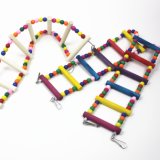Here are some types of bird foraging toys
2024-03-05
Foraging toys play a crucial role in providing mental stimulation and preventing boredom for pet birds. Birds are naturally curious and intelligent animals, and foraging toys encourage them to engage in natural behaviors, such as searching for food. Here are some types of bird foraging toys:
1. Foraging Feeders:
- These are containers or feeders that require birds to manipulate or solve a puzzle to access their food. For example, acrylic or stainless steel foraging balls with openings can be filled with treats or pellets, and the bird must roll or shake the ball to release the contents.
2. Foraging Boxes and Pouches:
- Boxes or pouches made of bird-safe materials can be filled with treats or foraging material. Birds have to explore and figure out how to access the rewards inside.
3. Puzzle Feeders:
- Puzzle feeders are designed to challenge a bird's problem-solving skills. They may have sliding compartments, rotating parts, or hidden chambers that require manipulation to reveal the food.
4. Paper Roll Foragers:
- Empty paper towel or toilet paper rolls can be filled with treats or seeds and then folded or closed at both ends. Birds must chew through the paper to access the hidden rewards.
5. Shreddable Foraging Toys:
- These toys are made of materials that birds can shred, such as natural fibers, cardboard, or palm leaves. Hidden treats or food items can be placed within the shreddable material, encouraging birds to explore and tear apart the toy.
6. Foraging Wheels and Spinners:
- These toys feature rotating parts or spinning chambers that birds can manipulate to access hidden treats. As the bird turns the wheel or spinner, treats are revealed.
7. Treat Puzzles:
- Treat puzzles are three-dimensional puzzles that birds must solve to obtain rewards. These puzzles can have moving parts, sliding components, or compartments that birds need to figure out to access treats.
8. Foraging Mats:
- Mats made from bird-safe materials, such as woven palm leaves or other natural fibers, can be scattered with treats. Birds can then explore and forage through the mat to find their rewards.
9. Hanging Foraging Toys:
- Foraging toys can be suspended from the cage ceiling, encouraging birds to climb or manipulate the toy to access hidden treats. Hanging toys often incorporate beads, chains, or other interactive elements.
10. Natural Foraging Branches:
- Securing treats or fruits onto natural branches or hanging them from the cage provides birds with a more natural foraging experience. Birds can use their beaks and feet to extract the treats.
11. Acrylic Foraging Cubes:
- Transparent acrylic cubes with multiple compartments and openings can be filled with a variety of treats. Birds must learn how to access the treats by manipulating the cube.
12. Edible Foraging Toys:
- Foraging toys made from bird-safe edible materials, such as cuttlebone, coconut shells, or baked loofah, allow birds to chew and explore while also providing a nutritional component.
When introducing foraging toys to your pet bird, start with simpler designs and gradually increase the complexity as your bird becomes more adept at using them. Regularly rotate and vary the foraging toys to maintain your bird's interest and mental stimulation. Always ensure that foraging toys are made from safe materials suitable for birds and regularly inspect them for wear and tear.



